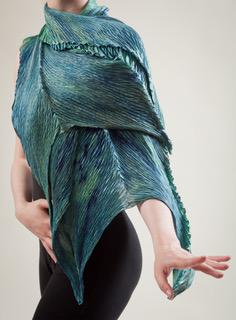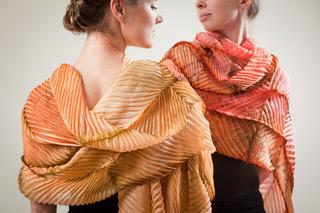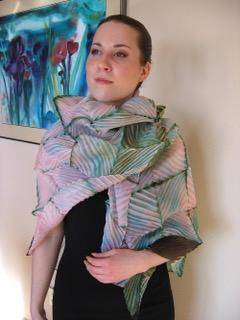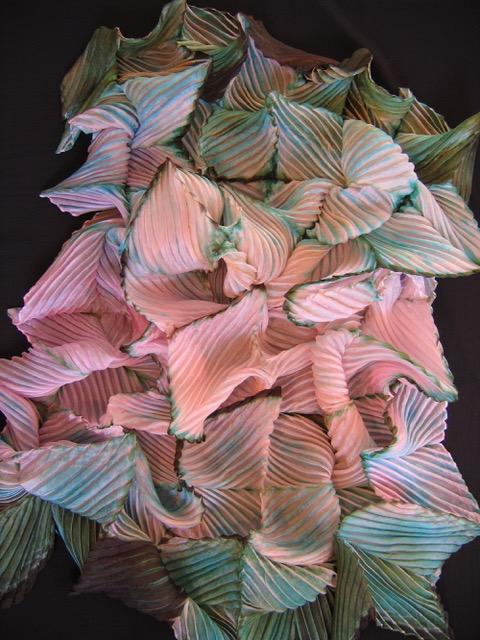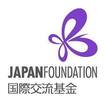|
Next Class Dates:
ARASHI SHIBORI 2-DAY WORKSHOP DATE: TBA This class has a $120 materials fee that can be paid directly to the instructor on the first day of class. Fee covers the cost of 1 yard silk material ($30) and 4 scarves (@$20) and dyes and mordants. Ages 16 and up welcome. Shibori techniques on silk Shibori has been a traditional way of dyeing kimono silks for 400 years in Japan. As modern methods replace traditional hand-crafts and craftspeople die out these skills are becoming rarer and the craftsmanship is being lost. This class leans heavily on the traditional and unchanged hand skills and dye methods that are intrinsic to authentic Japanese textile craft. Nevertheless modern style and applications will also be shown and we use modern equipment to speed up the process, so we can get a lot done in two days!! In this class for beginners Wendy Smith-Wood will introduce and develop three main traditional Shibori dyeing techniques: Arashi shibori (pole-winding) Winding silk on a pole and producing both flat and textured scarves. Itajime (block-resist) Using blocks to resist the dye in vats to produce repeated geometric patterns on silk pieces. Ori-Nui (sewn resist) Hand and machine sewing through multiple layers to produce elaborate repetitive designs on a piece of silk cloth (or scarf). Students abilities and preferences will be taken into account through the class. We will progress through multiple techniques and each student can work towards making a final piece of great complexity. Classes are located at 37114 N thrill Hill Rd Eustis Florida 32736. Look for the dojo sign and follow the driveway to the top. Please park in the grassy area in front of the block building. |
Shibori (しぼり/絞り, from the verb root "shiboru" – "to wring, squeeze or press") is a Japanese manual tie-dyeing technique, which produces a number of different patterns on fabric.
There are many ways to create shibori, with techniques generally grouped into three categories: kōkechi, tied or bound resists; rōkechi, wax resists; and kyōkechi, resists where the fabric is folded and clamped between two carved wooden blocks. Most techniques recognized within these three categories have names and a number of varieties of technique.
The technique chosen and the resulting dyed fabric depends upon both the type of fabric and the dyestuff used. Shibori demands a pliant and easy-to-handle fabric. Some historic dyeing techniques - such as the original technique of tsujigahana - are now impossible to recreate entirely due to the fact that the fabric necessary for the technique is no longer produced.
The desired end result for shibori may be to create a larger pictographic or geometric design (as seen on many full-shibori kimono), or simply to display the shibori on its own. Differing techniques may be combined in some cases to achieve increasingly more elaborate results.
Kanoko shibori is what is commonly thought of in the West as tie-dye. It involves binding certain sections of the cloth using thread - traditionally a type of untwisted thread known as shike-ito - to achieve the desired pattern. The pattern achieved depends on how tightly the cloth is bound and where the cloth is bound. If random sections of the cloth are bound, the result will be a pattern of random circles. If the cloth is first folded then bound, the resulting circles will be in a pattern depending on the fold used.
Miura shibori is also known as looped binding. It involves taking a hooked needle and plucking sections of the cloth. Then a thread is looped around each section twice. The thread is not knotted; tension is the only thing that holds the sections in place. The resulting dyed cloth is a water-like design. Because no knot is used, miura shibori is very easy to bind and unbind, making this technique commonly used.
Kumo shibori is a pleated and bound resist. This technique involves pleating sections of the cloth very finely and evenly. Then the cloth is bound in very close sections. The result is a very specific spider-like design. This specific design requires very precise technique.
Nui shibori includes stitched shibori. A simple running stitch is used on the cloth then pulled tight to gather the cloth. The thread must be pulled very tight to work, and a wooden dowel must often be used to pull it tight enough. Each thread is secured by knotting before being dyed. This technique allows for greater control of the pattern and greater variety of pattern, but it is much more time consuming.
Arashi shibori is also known as pole-wrapping shibori. The cloth is wrapped on a diagonal around a pole. Then the cloth is very tightly bound by wrapping thread up and down the pole. Next, the cloth is scrunched on the pole. The result is a pleated cloth with a design on a diagonal. "Arashi" is the Japanese word for storm. The patterns are always on a diagonal in arashi shibori which suggest the driving rain of a heavy storm.
Itajime shibori is a shaped-resist technique. Traditionally, the cloth is sandwiched between two pieces of wood, which are held in place with string. More modern textile artists can be found using shapes cut from acrylic or plexiglass and holding the shapes with C-clamps. The shapes prevent the dye from penetrating the fabric they cover.
Our Instructor: Wendy Smith-Wood
Retired mountaineer and musher, Smith-Wood sensei is a fiber artist living with her husband on an Alaskan homestead at Sheep Mountain close to the Matanuska glacier. She spent fifteen years as a mountain guide on the old silk routes in the Pamirs and Karakorum mountains, and climbing in the Himalayas, Atlas, Alps and Pyrenees. Each winter she traveled to Alaska to mush dogs in her favorite wilderness.
For the past 10 years she has worked as a textile artist specializing in Arashi Shibori. She produces exquisite ‘haute couture’ scarves and shawls. She also paints on silk for a short time each summer and is experimenting with sculptural Shibori wall-art .
Her work has been sold to Hollywood, state Senators, the Kennedys and many, many Alaskans who have supported her over the years. She winters in Central Florida near the Dojo.
PBS video on Wendy: https://video.milwaukeepbs.org/video/i-am-an-off-the-grid-artist-indie-alaska-gbcwvk/
There are many ways to create shibori, with techniques generally grouped into three categories: kōkechi, tied or bound resists; rōkechi, wax resists; and kyōkechi, resists where the fabric is folded and clamped between two carved wooden blocks. Most techniques recognized within these three categories have names and a number of varieties of technique.
The technique chosen and the resulting dyed fabric depends upon both the type of fabric and the dyestuff used. Shibori demands a pliant and easy-to-handle fabric. Some historic dyeing techniques - such as the original technique of tsujigahana - are now impossible to recreate entirely due to the fact that the fabric necessary for the technique is no longer produced.
The desired end result for shibori may be to create a larger pictographic or geometric design (as seen on many full-shibori kimono), or simply to display the shibori on its own. Differing techniques may be combined in some cases to achieve increasingly more elaborate results.
Kanoko shibori is what is commonly thought of in the West as tie-dye. It involves binding certain sections of the cloth using thread - traditionally a type of untwisted thread known as shike-ito - to achieve the desired pattern. The pattern achieved depends on how tightly the cloth is bound and where the cloth is bound. If random sections of the cloth are bound, the result will be a pattern of random circles. If the cloth is first folded then bound, the resulting circles will be in a pattern depending on the fold used.
Miura shibori is also known as looped binding. It involves taking a hooked needle and plucking sections of the cloth. Then a thread is looped around each section twice. The thread is not knotted; tension is the only thing that holds the sections in place. The resulting dyed cloth is a water-like design. Because no knot is used, miura shibori is very easy to bind and unbind, making this technique commonly used.
Kumo shibori is a pleated and bound resist. This technique involves pleating sections of the cloth very finely and evenly. Then the cloth is bound in very close sections. The result is a very specific spider-like design. This specific design requires very precise technique.
Nui shibori includes stitched shibori. A simple running stitch is used on the cloth then pulled tight to gather the cloth. The thread must be pulled very tight to work, and a wooden dowel must often be used to pull it tight enough. Each thread is secured by knotting before being dyed. This technique allows for greater control of the pattern and greater variety of pattern, but it is much more time consuming.
Arashi shibori is also known as pole-wrapping shibori. The cloth is wrapped on a diagonal around a pole. Then the cloth is very tightly bound by wrapping thread up and down the pole. Next, the cloth is scrunched on the pole. The result is a pleated cloth with a design on a diagonal. "Arashi" is the Japanese word for storm. The patterns are always on a diagonal in arashi shibori which suggest the driving rain of a heavy storm.
Itajime shibori is a shaped-resist technique. Traditionally, the cloth is sandwiched between two pieces of wood, which are held in place with string. More modern textile artists can be found using shapes cut from acrylic or plexiglass and holding the shapes with C-clamps. The shapes prevent the dye from penetrating the fabric they cover.
Our Instructor: Wendy Smith-Wood
Retired mountaineer and musher, Smith-Wood sensei is a fiber artist living with her husband on an Alaskan homestead at Sheep Mountain close to the Matanuska glacier. She spent fifteen years as a mountain guide on the old silk routes in the Pamirs and Karakorum mountains, and climbing in the Himalayas, Atlas, Alps and Pyrenees. Each winter she traveled to Alaska to mush dogs in her favorite wilderness.
For the past 10 years she has worked as a textile artist specializing in Arashi Shibori. She produces exquisite ‘haute couture’ scarves and shawls. She also paints on silk for a short time each summer and is experimenting with sculptural Shibori wall-art .
Her work has been sold to Hollywood, state Senators, the Kennedys and many, many Alaskans who have supported her over the years. She winters in Central Florida near the Dojo.
PBS video on Wendy: https://video.milwaukeepbs.org/video/i-am-an-off-the-grid-artist-indie-alaska-gbcwvk/
